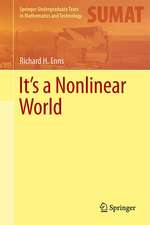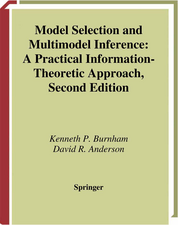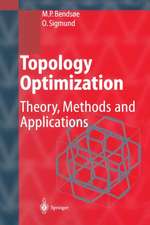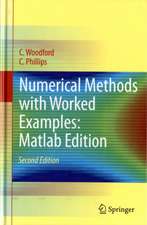Mathematical and Computational Modeling and Simulation: Fundamentals and Case Studies
Autor Dietmar P. F. Mölleren Limba Engleză Paperback – 19 aug 2003
Preț: 396.62 lei
Nou
Puncte Express: 595
Preț estimativ în valută:
75.92€ • 82.49$ • 63.81£
75.92€ • 82.49$ • 63.81£
Carte tipărită la comandă
Livrare economică 21 aprilie-05 mai
Preluare comenzi: 021 569.72.76
Specificații
ISBN-13: 9783540403890
ISBN-10: 3540403892
Pagini: 444
Ilustrații: XV, 422 p.
Dimensiuni: 155 x 235 x 23 mm
Greutate: 0.62 kg
Editura: Springer Berlin, Heidelberg
Colecția Springer
Locul publicării:Berlin, Heidelberg, Germany
ISBN-10: 3540403892
Pagini: 444
Ilustrații: XV, 422 p.
Dimensiuni: 155 x 235 x 23 mm
Greutate: 0.62 kg
Editura: Springer Berlin, Heidelberg
Colecția Springer
Locul publicării:Berlin, Heidelberg, Germany
Public țintă
GraduateCuprins
1 Modeling Continuous-Time and Discrete-Time Systems.- 1.1 Introduction.- 1.2 Modeling Formalisms.- 1.3 System Elements and Models of Continuous-Time Systems.- 1.4 Block Diagram-based Algebraic Representation of Systems.- 1.5 Basic Principles of Discrete-Time Systems.- 1.6 Model Validation.- 1.7 References and Further Reading.- 1.8 Exercises.- 2 Mathematical Description of Continuous-Time Systems.- 2.1 Introduction.- 2.2 Controllability, Observability, and Identifiability.- 2.3 Time Domain Solution of the Linear State Equation System.- 2.4 Solution of the State Equation using the Laplace Transform.- 2.5 Eigenvalues of the Linear Vector-Equation Systems*.- 2.6 Stability Analysis*.- 2.7 First-Order Linear State-Equation Models.- 2.8 Second-Order Linear State-Equation Models.- 2.9 Higher-Order Linear State-Space Models*.- 2.10 Nonlinear State-Space Models*.- 2.11 References and Further Reading.- 2.12 Exercises.- 3 Mathematical Description of Discrete-Time Systems.- 3.1 Introduction.- 3.2 Statistical Models in Discrete-Time Systems.- 3.3 Discrete-Event Simulation of Queuing systems.- 3.4 Petri-Nets.- 3.5 Discrete-Event Simulation of Parallel Systems.- 3.6 References and Further Reading.- 3.7 Exercises.- 4 Simulation Sofware for Computational Modeling and Simulation.- 4.1 Introduction.- 4.2 Digital Simulation Systems.- 4.3 Simulation Software for Continuous-Time Systems.- 4.4 Discrete-Time System Simulation Software*.- 4.5 Multi-Domain Simulation Software for Large-Scale Systems*.- 4.6 Simulation Software for Mixed-Mode Circuits*.- 4.7 Combined Simulation Software.- 4.8 Checklist for the Selection of Simulation Software.- 4.9 References and Further Reading.- 4.10 Exercises.- 4.11 Case Study Examples.- 5 Parameter Identification of Dynamic Systems.- 5.1 Introduction.- 5.2 Mathematical Notation of the Identification Task.- 5.3 Identification Task.- 5.4 Output-Error Least Squares Method*.- 5.5 Equation-Error Least Squares Method*.- 5.6 Consistency of the Parameter Estimates*.- 5.7 Consistency Modifications of the Equation-Error Method*.- 5.8 Identifiability*.- 5.9 System Input Properties*.- 5.10 Parameter Identification of the Cardiovascular System*.- 5.11 Error-Functional Minimization by Gradient Methods*.- 5.12 Error-Functional Minimization by Direct Search Methods*.- 5.13 Identifiability and the Output-Error Least Squares Method*.- 5.14 References and Further Reading.- 5.15 Exercises.- 6 Soft-Computing Methods.- 6.1 Introduction.- 6.2 Fuzzy Logic.- 6.3 Neural Nets*.- 6.4 References and Further Reading.- 6.5 Exercises.- 7 Distributed Simulation.- 7.1 Introduction.- 7.2 Distributed Simulation of Traffic and Transportation.- 7.3 Introduction into HLA*.- 7.4 References and Further Reading.- 7.5 Exercises.- 8 Virtual Reality.- 8.1 Introduction.- 8.2 Virtual Reality applied to Medicine.- 8.3 Virtual Reality in Geo Science*.- 8.4 DDSim Prototyping Tool for Autonomous Robots.- 8.5 References and Further Reading.- 8.6 Exercises.- Appendix A.- Numeric Integration.- Single-Step Formulae.- Multi-Step Formulae.- Appendix B.- Laplace Transform.- Appendix C.- Online Resources.
Textul de pe ultima copertă
Mathematical and Computational Modeling and Simulation - a highly multi-disciplinary field with ubiquitous applications in science and engineering - is one of the key enabling technologies of the 21st century. This book introduces to the use of Mathematical and Computational Modeling and Simulation in order to develop an understanding of the solution characteristics of a broad class of real-world problems. The relevant basic and advanced methodologies are explained in detail, with special emphasis on ill-defined problems. Some 15 simulation systems are presented on the language and the logical level. Moreover, the reader can accumulate experience by studying a wide variety of case studies. The latter are briefly described within the book but their full versions as well as some simulation software demos are available on the Web. The book can be used for University courses of different level as well as for self-study. Advanced sections are marked and can be skipped in a first reading or in undergraduate courses.
Caracteristici
Describes discrete and continous time modeling and simulation Presentation on an engineering student level With examples and more than 50 embedded case studies from all engineering disciplines














